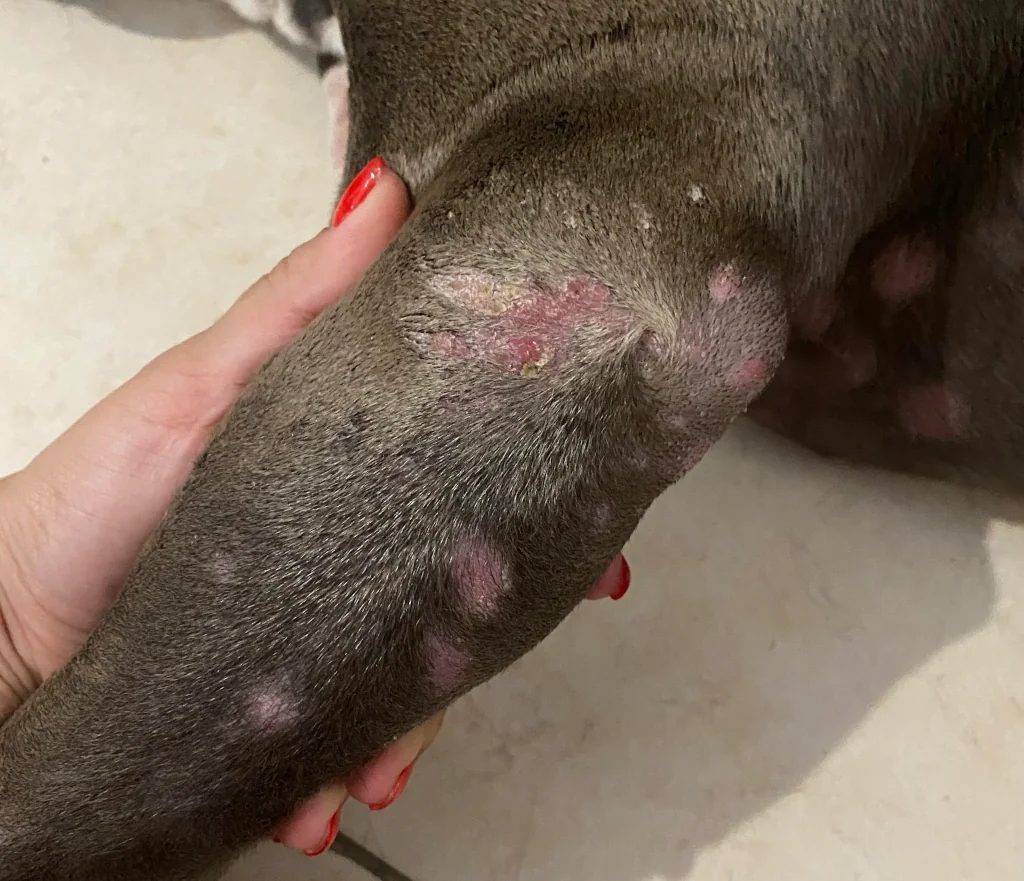Disclosure: We may earn a commission from helpful, relevant links in our content. No cost to you. See our privacy policy.
A sudden itch that won’t stop, a coat that’s lost its shine – seeing your furry friend in discomfort is tough.
Skin issues can make your dog’s daily romps and rambles a real struggle, turning joy into discomfort. We understand your concern, and it’s why we’re here.
You need answers, and most importantly, solutions. That’s why we’ve created this in-depth guide that isn’t just about identifying the problems but also about effectively addressing them.
Together, we will illuminate the complexities of canine skin issues, and more importantly, the solutions to restore the pep in your pooch’s step. Stick around, because this is the beginning of a healthier chapter for your four-legged friend.

What Are the Most Common Skin Diseases in Dogs?
Skin problems in dogs are as varied as they are common. While there’s a long list, we’re narrowing it down to the most prevalent ones that you, as a dog owner, should be aware of.
Allergies
One of the most prevalent skin issues in dogs is allergies. Dogs can be hypersensitive to a multitude of triggers, including food, insect bites, and even certain types of pollen. These allergens typically cause itchy skin, hives, and inflammation.
A practical tip for managing allergies in dogs is to keep a keen eye on their diet and immediate environment. If you notice a reaction, consulting with a vet to conduct an allergy test can help you identify the trigger and adjust their lifestyle accordingly.
Dermatitis
Irritant dermatitis is another common skin ailment in dogs. Often caused by exposure to harsh detergents or certain plants, symptoms include redness, swelling, and sometimes sores.
Owners with dogs suffering from dermatitis should consider the use of hypoallergenic shampoos and detergents. Additionally, keeping the dog’s environment free of irritant plants can also prove beneficial. Even the mold in the plants might cause allergies in your dog, so try to be mindful about that.
Mange
Caused by tiny mites burrowing into your dog’s skin, Mange results in hair loss, sores, and severe itching. Regularly checking your dog’s skin for any signs of pests can help prevent this issue.
Certain breeds like Bulldogs and Shar-Peis are more susceptible to this condition due to their skin folds. If your dog gets diagnosed with mange, following the prescribed treatment plan diligently is crucial to eradicate these stubborn mites.
Ringworm
Ringworm is a misnomer. It’s actually a fungal infection characterized by circular patches of hair loss with a red ring at the outer edge. Quick to spread but slow to heal, ringworm needs prompt and rigorous treatment.
Remember to keep the infected area clean and dry, and isolate your dog from others to prevent spread. Your vet will likely recommend a topical antifungal medication or, in severe cases, oral medication.
Yeast Infection
Lastly, yeast infections are common in dogs with skin that is constantly moist. They lead to foul smells, redness, and inflammation.
This issue is often prevalent in breeds with floppy ears or skin folds, such as Bulldogs and Cocker Spaniels. Regular cleaning of these areas with a vet-approved cleanser can help keep yeast infections at bay.
Understanding these conditions is not just about recognizing the symptoms, it’s also about knowing what practical steps you can take to avoid or manage them. As a dog owner, your proactive approach can make a world of difference to your pet’s health and happiness.
How Do You Treat Skin Issues in Dogs?
The treatment for skin issues in dogs can vary widely based on the underlying cause. That said, let’s explore some fundamental steps in addressing these problems:
- Vet Consultation. As a first line of action, ensure your furry companion sees a vet. The same symptoms can suggest different conditions, making a professional diagnosis crucial. For instance, if the issue is an allergy, a vet could administer an intradermal skin test or blood test to identify the allergen.
- Medication. Based on the diagnosis, your vet may prescribe various treatments. For bacterial infections, common antibiotics like Cephalexin or Clindamycin might be used. Antifungal medications, such as Ketoconazole, can be effective for yeast infections. If the issue is parasitic, like mange, your vet may prescribe Ivermectin. And for inflammation or severe itching, a steroid like Prednisone could be suggested.
- Special Diets. A diet switch can be transformative for dogs with food allergies. Vets often recommend a novel protein or hydrolyzed diet, where the protein source is something the dog has never eaten before or is broken down to a level the immune system doesn’t recognize. This can help identify the allergen and alleviate the skin symptoms.
- Topical Treatments. There’s a wide range of medicated shampoos, ointments, and creams that can soothe the skin and fight pathogens. For example, a shampoo with Chlorhexidine can help with bacterial and fungal skin infections. It’s vital to leave these products on for the recommended amount of time, usually 10 minutes, before rinsing for maximum efficacy.
- Immune Modulating Therapy. In chronic cases like atopic dermatitis, your vet may recommend drugs that modulate the immune response, such as Oclacitinib (Apoquel) or Cyclosporine. These medications require close monitoring but can significantly improve quality of life in severe cases.
Remember, the treatment plan should be tailored to your dog’s specific needs. Adherence to your vet’s instructions and regular follow-ups are key to managing these skin issues successfully.
Having been in the field for years, we’ve seen how timely intervention and dedicated care can bring about incredible improvements, turning distressed dogs into happy, healthy pups again.

Can You Treat Dog Skin Issues at Home?
While professional veterinary care is irreplaceable, there are ways to provide relief to your furry friend at home, especially for mild cases. However, these should not replace a vet visit but complement it:
- Regular Bathing. Use a gentle, hypoallergenic dog shampoo to soothe irritated skin and remove allergens. Do not overdo it, as frequent bathing can dry out your dog’s skin.
- Proper Nutrition. A balanced diet that includes Omega-3 and Omega-6 fatty acids can boost your dog’s skin health.
- Regular Grooming. Brushing not only keeps your dog’s coat shiny but also distributes natural oils evenly across the skin, reducing dryness and itchiness.
- Use of a cone. Also known as ‘cone of shame’, this collar can prevent your dog from scratching or biting affected areas, thus preventing further damage.
Remember, every dog is unique and so is their reaction to different treatments. Keep a close eye on your furry friend and monitor their response to these measures. Your care, vigilance, and love, combined with your vet’s expertise, are the best treatments for your pup’s skin problems.
Related: How to Choose a Dog Shampoo
How Can You Prevent Skin Issues in Dogs?
Keeping your dog’s skin healthy can be a proactive task.
Nourishing food forms the foundation of not just their overall well-being but particularly their skin health. When choosing dog food, opt for high-quality options rich in omega fatty acids and antioxidants. These nutrients help support a healthy skin barrier and decrease inflammation, which can reduce the likelihood of skin problems.
Just as important as a good diet is regular exercise. Exercise improves blood circulation, delivering oxygen and nutrients more effectively to your dog’s skin. It also aids in maintaining a healthy weight, reducing the risk of skin issues associated with obesity, like skin folds where infections could fester.
Don’t overlook the importance of routine vet visits. Regular check-ups enable early detection of potential health issues, including those that may first manifest subtly in your dog’s skin. A professional can identify and address any concerns promptly, thwarting more serious complications down the line.
For dogs with known allergies, managing their environment can be a significant part of preventing skin issues. This management can involve modifying their diet, opting for hypoallergenic bedding, or even adjusting outdoor time during high-pollen seasons. It’s about controlling what you can to minimize their exposure to known allergens.
Lastly, a tip that you might not find in every dog health guide: sun protection. Yes, dogs, particularly those with short hair or light skin, can get sunburned too! By using pet-safe sunscreens and avoiding peak sunshine hours, you can provide an additional layer of protection for your dog’s skin.
Preventing skin issues in dogs isn’t just about responding to symptoms but rather about creating a lifestyle that supports optimal skin health.

Dos and Don’ts in Dog Skin Treatments
Do:
- Consult your vet before starting any treatment regimen. They know your dog’s health history and are the best resource for effective and safe treatments.
- Monitor your dog’s reaction to any new treatment or product. If you notice any adverse reactions, stop the treatment and consult your vet immediately.
- Follow the prescribed course of any medication, even if your dog seems better before it’s finished. Ending treatment prematurely may result in relapse or resistance.
Don’t:
- Avoid self-diagnosing your dog’s skin condition. Skin issues can have similar symptoms but require different treatments.
- Never apply human skin products to your dog without consulting your vet. Some substances safe for humans can be harmful or even toxic to dogs.
- Don’t ignore minor symptoms. If untreated, minor skin issues can escalate into severe conditions. If you notice changes in your dog’s skin or coat, it’s better to err on the side of caution and visit your vet.
Related: How to Choose the Best Dog Shampoo for Allergies
Can Dog Skin Issues Become Fatal?
Although the majority of dog skin conditions are not life-threatening, their impact should not be underestimated.
Chronic discomfort, constant itchiness, or recurring infections can significantly diminish your pet’s quality of life.
Certain severe conditions, such as deep pyoderma, pemphigus complex, or malignant skin tumors, can indeed pose serious health risks if left untreated. Even common ailments like allergies, if unaddressed, can lead to secondary infections due to excessive scratching and biting.
So, while skin issues might not directly cause fatality, they can act as a gateway to more severe complications. It’s vital to treat any skin problem promptly and effectively, not only for your dog’s skin health but also for their overall well-being.
As pet parents, we understand the distress that comes with seeing your dog suffer. But remember, in the world of pet health, vigilance, and timely intervention are the game-changers.
FAQs
Can dog skin issues spread to humans?
Dog skin issues can potentially spread to humans in certain cases. Zoonotic diseases like ringworm or scabies are examples where transmission is possible. However, maintaining good hygiene practices can significantly reduce the risk.
What ointment is good for dog skin infections?
For treating skin infections in dogs, a commonly recommended ointment is mupirocin. It’s effective against a range of bacterial infections. However, always consult with a vet before using any ointment to ensure it’s suitable for your dog’s specific condition.
Are some dog breeds prone to skin issues?
Yes, certain breeds, including Bulldogs, Shar-Peis, and Dalmatians, among others, are genetically predisposed to skin issues. However, environmental factors, diet, and lifestyle can also play a significant role in a dog’s susceptibility to skin problems.
Alex, a passionate animal lover, has experience in training and understanding animal behavior. As a proud pet parent to two dogs and three cats, he founded AnimalReport.net to share insights from animal experts and expand his knowledge of the animal kingdom.




